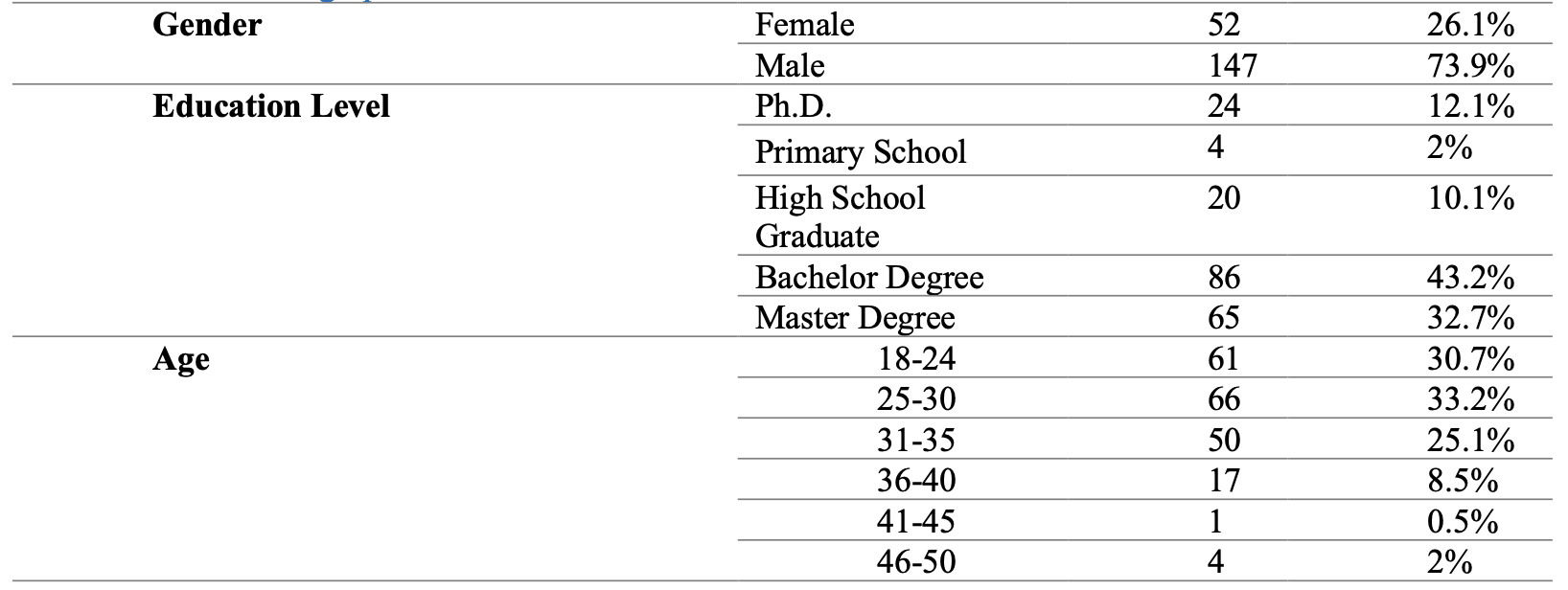An Analysis of the Driving Factors Behind Afghan Youth Migration to Türkiye
DOI:
https://doi.org/10.38043/jimb.v9i2.6206Keywords:
Migration, Push Factors, Pull Factors, Youth, Afghanistan, TurkeyAbstract
This study investigates the factors driving Afghan youth migration to Turkey using primary data from 199 respondents via an online survey. Analysis of demographic characteristics and migration experiences reveals that Afghan youth migrants to Turkey, predominantly male (73.9%) with an average age of 28 years, hold high levels of education, with 43.2% possessing bachelor’s degrees and 32.7% holding master’s degrees. The research finds that a significant portion of Afghan youth migrants encounter challenges and discrimination during migration, with 80.4% reporting difficulties and 68.8% experiencing discrimination. Furthermore, a large majority (84.4%) do not intend to remain in Turkey, indicating a transient migration pattern. Key push factors identified include political instability (cited by 57.8% of respondents) and economic factors such as unemployment and poverty (influencing 34.7% of respondents). Conversely, the education system in Turkey emerges as a prominent pull factor, influencing migration decisions for 49.2% of respondents. Correlation analysis shows a statistically significant positive relationship (Pearson correlation coefficient = 0.187**, p = 0.008) between satisfaction with migration and pull factors, emphasizing their importance. Regression analysis highlights the impact of political factors, support from the Turkish government, and integration into Turkish society on satisfaction with migration decisions. Notably, political factors (B = 0.134, p = 0.042), government support (B = 0.173, p = 0.004), and integration (B = 0.204, p = 0.011) significantly influence satisfaction. Findings offer insights for cross-cultural workforce integration management, providing valuable implications for policymakers and organizations working with migrant populations.
Downloads
References
Barlas, A. W., & Ammar, A. (2022). Do Afghan Youth Think of Migrating to other Countries under the Taliban Regime?
Bulgurcuolu, S. E., & Atas-Topcuolu, R. (2024). The precarious lives and survival strategies of unaccompanied Afghan youth in Trkiye. Asian and Pacific Migration Journal, 01171968241235238.
Buz, S., Memiolu, F., Dnmez, H., & Verduijn, S. (2020). Destination Unknown Afghans on the move in Turkey. Mixed Migration Center.
Erol, H., & Ali, A. M. (2022). Reasons for the migration from Afghanistan to Turkey: aegean region example. Ege Stratejik Aratrmalar Dergisi, 13(1), 27-38.
Gul, S. (2023). Factors That Influence the Life Satisfaction of Afghan Refugees Living in Eastern Turkey: The Role of Their Migration Causes. Sustainability, 15(20), 14853.
Gler, . U., & Bkey, A. M. (2024). International Forced Migration and Employment Relations: The Case of Syrians in Trkiye. Turkish Journal of Diaspora Studies, 4(1), 1-21.
Hashemi, S. R. (2021). An Analysis of Opportunities and Challenges towards the Afghan Immigrants in Turkey. International Journal of Geography and Geography Education, (43), 159-172.
Hashem, S. R., & zey, R. (2020). INVESTIGATING THE POLITICAL FACTORS OF AFGHAN MIGRATION. lnternational Journal of Geography and Geography Education, (42), 263-277. https://doi.org/10.32003/igge.649369
duygu, A., & Karada, S. (2018). Afghan migration through Turkey to Europe: seeking refuge, forming diaspora, and becoming citizens. Turkish Studies, 19(3), 482-502. https://doi.org/10.1080/14683849.2018.1454317
duyugu, A., & Kirici, K. (2009). Forced Migration: The Afghan Experience. Routledge.
Koser, K. (2014). Transition, crisis and mobility in Afghanistan: rhetoric and reality. International Organization for Migration, Kabul.
POUYA, J. (2022). THE CAUSES OF AFGHAN IMMIGRATION TO TRKYE. Ortadou ve G, 12(2), 286-310.
Savc, B. . Z., Pries, L., & Erdoan, M. M. (Eds.). (2024). Forced Migration in Turkey: Refugee Perspectives, Organizational Assistance, and Political Embedding. Taylor & Francis.
Sulianto, Akba, . Z., Aygl, H. H., Grbz, G., & Kurtulu, S. (2022). The Religious Life of Afghan Migrants Before and After Migration: Protecting Their Religious Identity or Social Cohesion. Ilahiyat Studies, 13(2), 207-255.
UNHCR. (2019). UNHCR Global Trends Report. Retrieved from https://www.unhcr.org/globaltrends2019/
UNHCR. (2024). Afghanistan. Retrieved from https://data.unhcr.org/en/situations/afghanistan
UNHCR. (2024). Afghanistan. Retrieved from https://www.unhcr.org/countries/afghanistan
UNICEF Innocenti Global Office of Research and Foresight. (August 2023). As They Move: Child and youth migration, displacement and return in Afghanistan. UNICEF Innocenti, Florence
Arifoglu, A. T., & Artan, T. (2024). A systematic review of the factors influencing the risky behaviors of syrian forced migrant children and adolescents in Turkey. Clinical Child Psychology and Psychiatry, 29(3), 1195-1212.
Alemi, Q., Stempel, C., Koga, P. M., Smith, V., Danis, D., Baek, K., & Montgomery, S. (2017). Determinants of health care services utilization among first generation afghan migrants in Istanbul. International journal of environmental research and public health, 14(2), 201.
zuygun, M. E. (2024). Trkiye's Immigration Landscape: Cultural Exchange and Labor Dynamics with Africa. Journal of Central and Eastern European African Studies, 4(1), 32-54.
Meloni, F. (2021). The limits of freedom: Migration as a space of freedom and loneliness among Afghan unaccompanied migrant youth. In Children of the Crisis (pp. 109-124). Routledge.
Scalettaris, G., Monsutti, A., & Donini, A. (2021). Young Afghans at the doorsteps of Europe: the difficult art of being a successful migrant. Journal of Ethnic and Migration Studies, 47(3), 519-535.
duygu, A., & Aksel, D. B. (2015). Migration realities and state responses: Rethinking international migration policies in Turkey. In Social transformation and migration: National and local experiences in South Korea, Turkey, Mexico and Australia (pp. 115-131). London: Palgrave Macmillan UK.
Dvell, F. (2020). Shifts in the global migration order and migration transitions in Europe: the cases of Turkey and Russia. Comparative migration studies, 8(1), 45.
Donini, A., Monsutti, A., & Scalettaris, G. (2016). Afghans on the move: seeking protection and refuge in Europe. Global Migration Research Paper, 17.

Downloads
Published
How to Cite
Issue
Section
License
Copyright (c) 2024 Abdul Qayum Shafaq, Hameedullah Shuaa

This work is licensed under a Creative Commons Attribution-ShareAlike 4.0 International License.
